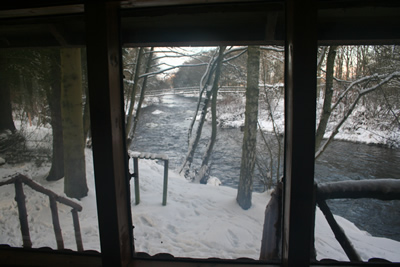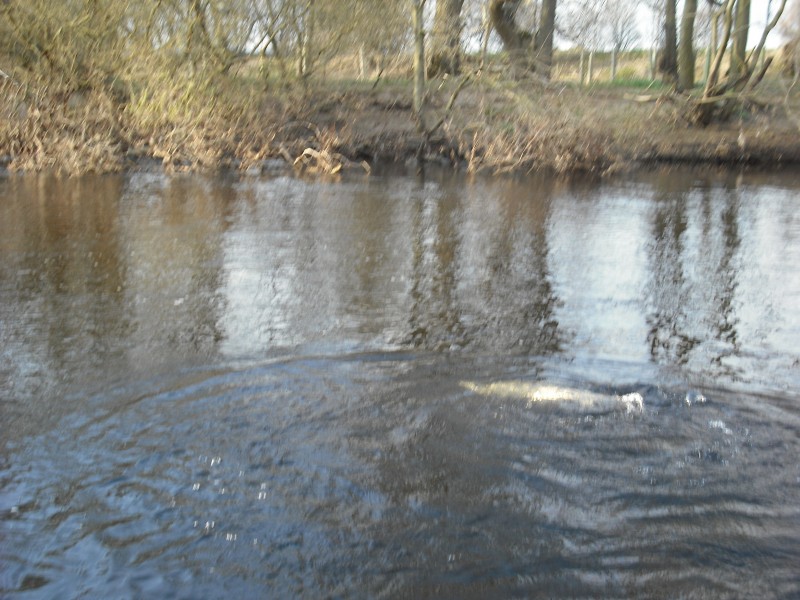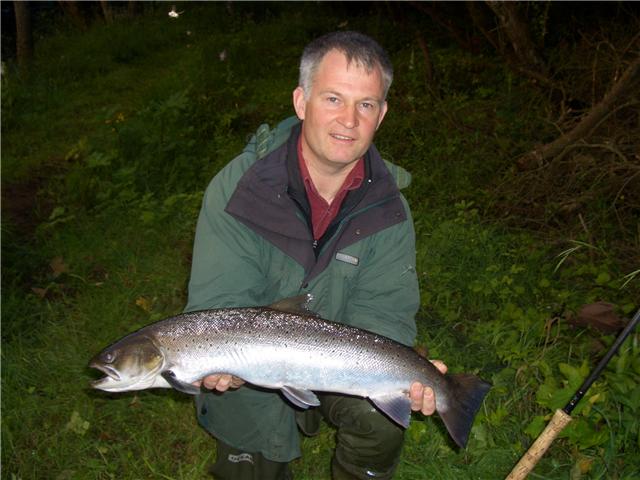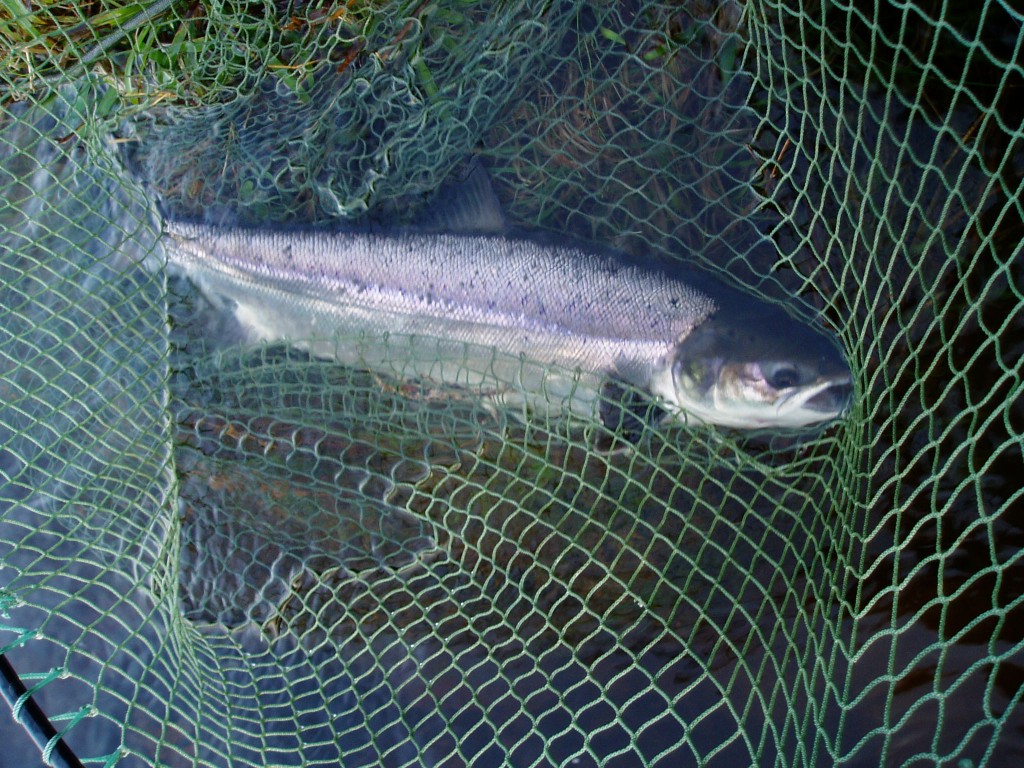The winter solstice has come and gone and the days, while not yet getting noticeably longer, are not getting any shorter. The full moon is now waning after a full eclipse early in the morning on Tuesday and the winter skies are clear and provide no protection during the cold nights. With temperatures down to minus 15C at night, and not going above minus 5C for the last week, the river is frozen over at Tyndals and the Boat Pool, with black looking streams appearing through the ice in places and then disappearing beneath it a few yards downstream.
Salmon are cold blooded animals, and the effect of low temperatures is to slow down their metabolism and give them an energy-saving lethargy as they lie in deep water below the ice. Unlike humans, who would soon die of hyperthermia if they were subjected naked to such conditions, salmon can survive for a long time in near zero temperatures. In Russia for example, they have ice-fish. These are salmon that run rivers like the Varzina and Ponoi in the late autumn, spend the winter under the ice and become available – as silver fish – to the angler arriving at the beginning of June as the ice melts. These ice-fish then go on to spawn in the autumn of that year, after spending more than a year in fresh water. We don’t have ice-fish on the South Esk because the river only freezes over on average one winter in five. But we do have distinct populations of salmon, probably genetically differentiated after developing particular characteristics since the last ice age, that run the river in nearly every month of the year.
Salmon spawning this autumn (below)
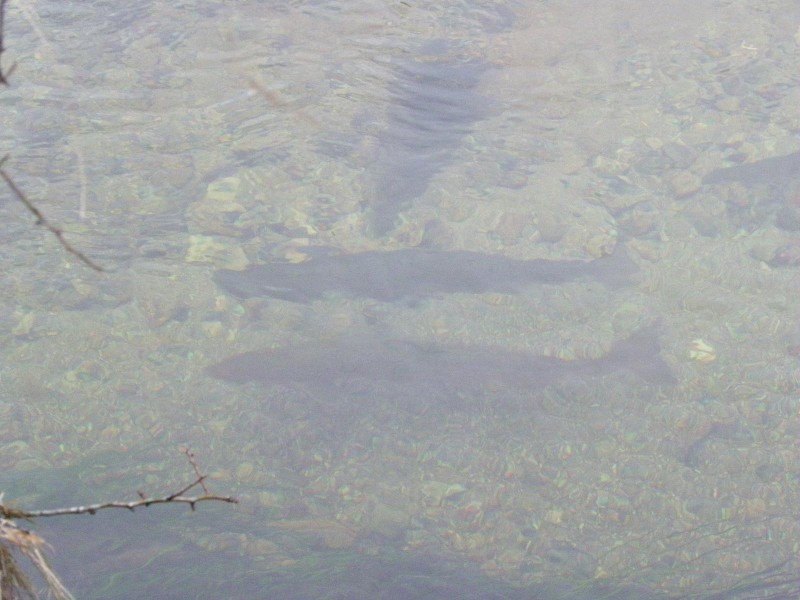
Spawning salmon
Here (below) is a picture of one of our October tenants, Mike Eliot, with a red cock fish which he carefully returned to the River. I wonder where that fish is now? Has it hunkered down in some deep pool awaiting the moment to move onto the redd with its mate? Or has the deed been done, the eggs fertilised and the fish – now a kelt – awaits the near inevitability of death? Whatever happened to it, unless it was taken by an otter or unseasonal poacher, I imagine it still alive, living out its last days in the cold river. Winter may appear to be cruel, but it is also the source of next spring’s regeneration.
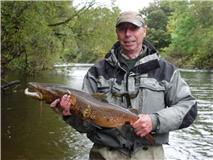
Mike Eliot returning a cock salmon
Winter pictures taken over the last few days show Finavon in the grip of this unusually cold weather.
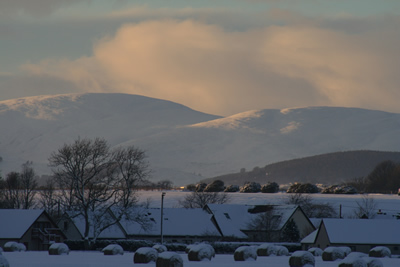
Autumn & Winter 2010
This is the view on the 24th December 2010 of the hills behind the rooftops of Finavon Village. The snow in the high Corries will be tens of feet deep, drifted by the wind. The blocks of frozen snow and ice packed into the corries will become the reservoir to give the spring salmon sufficient water to swim well up into the South Esk system. Were all winters as generous to the most valuable salmon of all – the early running or ‘spring’ fish! If the last few years had not produced such mild winters, who knows whether our spring salmon populations wouldn’t now be more abundant than they appear to be? I like cold winters: they are good for the river and produce better feeding at sea and along the coast for salmon and sea trout!
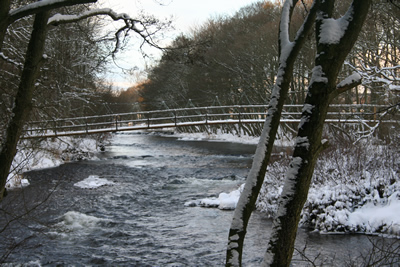
View upstream from RB Hut
This is the view from the Red Brae Hut looking upstream towards the footbridge with Castle Stream and the Flats beyond. These two streamy pools provide top quality habitat for feeding salmon and sea trout parr in the spring and summer months, but in the winter these little fish bury themselves at times in the loose gravel (from where they emerged as alevins) where they are safe from predators and the disruption caused by winter floods. When we electro-fished the Flats we discovered that the density of parr in that shallow pool was as high as anywhere on the river.
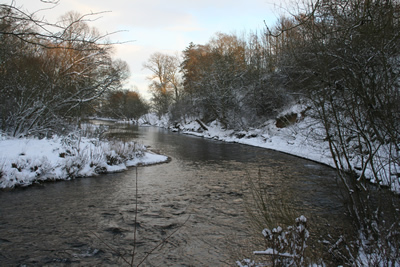
Red Brae in November snow
Red Brae is a great holding pool. I often think that there must be at least one salmon in it in every month of the year, and I’m not including kelts! The thing about the Red Brae is that it has a great stream in at the head of the pool, down to the confluence with the Lemno Burn. And then there’s the wall which runs beneath the red brae itself where the current erodes into the hillside a bit more every year. Salmon lie right up against and below the wall, sometimes with their heads tucked under it, often preventing them from seeing a fly. Nevertheless, this section of the pool provides depth and security and holds good numbers of fish throughout the season. Last, but not least, is the tail of the pool which is the section from the end of the Wall (a great taking place!) into Kirkinn. In these winter conditions (see photo above) I think of those soft July evenings with the sea trout swirling in the tail of the pool, and grilse and salmon head & tailing in the head stream and at the end of the Wall. It is only three years ago that I caught three salmon in an August spate – all over 12lbs – at the end of the Wall without moving my feet. This happened because at the right river level there is a lie at the point where the current deflects away from the broken wall. There was a pod of fresh fish there, all of which were keen on taking the fly. Memories!
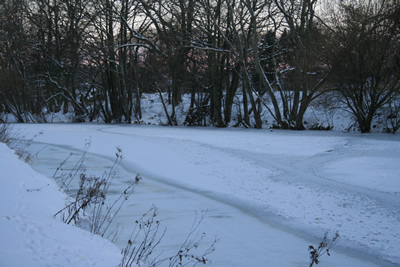
Upper Boat iced
This is Upper Boat Pool just downstream of Willows. The pool has been frozen over for ten days and heavy snow fell onto the ice last week. The current is slow here and the river quite deep, with the result that the river freezes right across and then acts as a dam to catch all the ice flows coming down the river. The effect of this is a corrugated surface of the ice upstream of the smooth frozen-over Boat Pool. In the photograph below you will see how this corrugation affects Willows – our most productive pool at Finavon, but certainly not in these conditions!

Willows iced
Note the corrugated surface of the pool, which is the result of ice flows trapped by the dam of ice in the Boat Pool. Willows is the most productive pool on all four beats of Finavon Castle Water. The pool offers superb high water fishing for salmon in the spring and autumn but, best of all, it is a great place to catch sea trout. The secrets of success for this pool are the deep water in Boat Pool which provides a reliable stock of salmon and sea trout to filter up into the shallower water (about 4′ 0″ deep) at the head. It is this shallower water with the bank of willows along the north bank to provide shade and security for fish that makes this pool so productive. But Willows is not easy to fish in low water. Genuine fieldcraft is required, as well as the night fishing angler taking great care to wade as quietly as possible. Once ensconced in the pool, moving very quietly down, step by step, you soon become as one with the natural surroundings – to the extent that you may find otters surfacing and exhaling breath noisily within a rod’s length of where you are standing! That can be quite scary if you are not ready for it. Sea trout shoals in the Boat Pool can number 300 or more, and many of these fish will at some time during the short summer nights become available to the careful angler. Images of the summer again, in sharp contrast to the wintry scene above!

Dawn over Finavon Hill Dec 2010
Sunrise over Finavon Hill on Christmas Day 2010
TA

